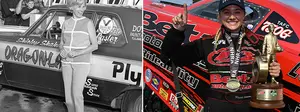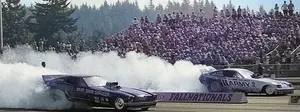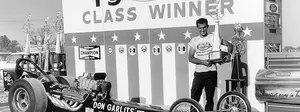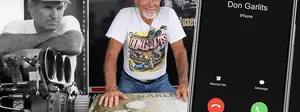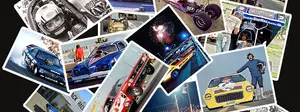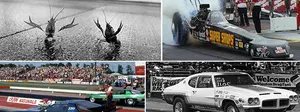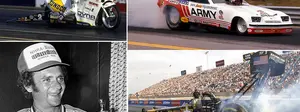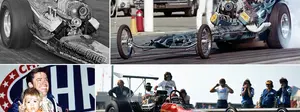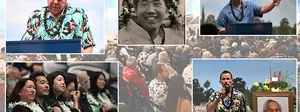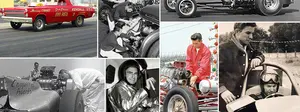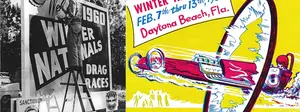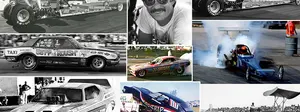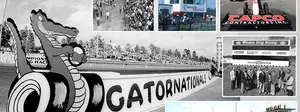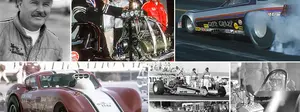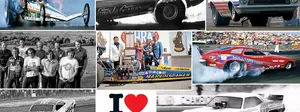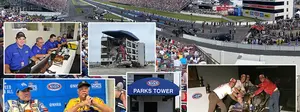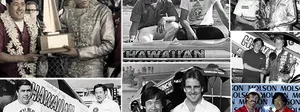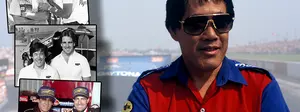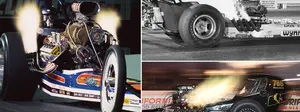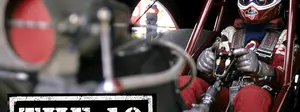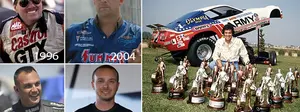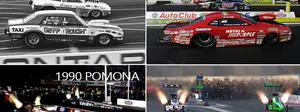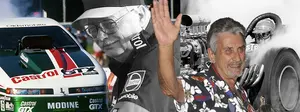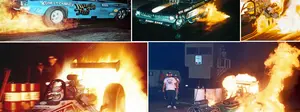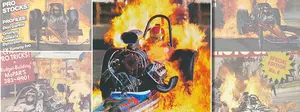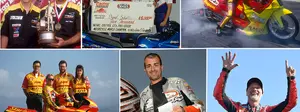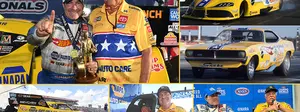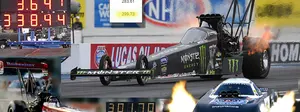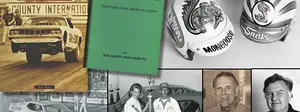Herm Petersen: 'I’ve Survived Damn Near Everything'
 |
The button on Herman Petersen’s trademark brown hat pretty much sums it all up: “I’ve Survived Damn Near Everything.” It’s not an idle boast.
The Washington state nitro veteran, known as "the Northwest Terror," has stared down death on at least four occasions -- only two of which were related to racing -- and came out the other side each time with a brighter outlook on life.
To shake his hand is to touch the soul of humanity. His gnarled hands, missing at least the tips of each finger, are mute testimony to the ravages of a terrible fire suffered at the wheel of his dragster just more than 40 years ago, yet it’s a welcoming handshake.
And the smile that brightens a face that also shows the scars of that fire is testimony to the resiliency of the human spirit and to a man at peace with his place in the world, one who assigns the proper perspective to the joys and sorrows that 70 years of life can bring.
It’s pretty safe to assume that the knowledgeable readers in the Insider Nation know the basics of Petersen’s tale, of that fateful July day in 1973 at Orange County Int’l Raceway when a crash and ensuing fire forever changed his life, of his courageous comeback, and of his retirement just a few years later, but as you’ll read in the next two parts concluding next Friday, the frightening accident at OCIR was only the better-publicized portion of a wonderful life inside and out of racing.
As I mentioned last week, I had been trying to get together with Petersen for a few years, but because he’s seemingly always on the go and I hadn’t traveled to our Seattle event in more than a decade, it never happened. I added Seattle to my schedule this year, and a note from Petersen a few weeks before the event invited me to drop by his display area to see his latest treasure, a bright-orange supercharged ’52 Willys – the same make and model of his first race car decades ago – that would serve as the push vehicle for his restored slingshot dragster that would take part in Sunday’s Cacklefest. I had hoped to carve out close to an hour during Friday qualifying to sneak away from my reporting duties, but just as we sat down, it began to rain, and it continued for several hours, making for a leisurely and pleasurable trip down his Memory Lane.
Getting started
Like a lot of guys in the 1960s, Petersen became acquainted with drag racing through his local car club, which in his case was the Handlers, which called Bremerton Raceway its home, but he was into cars long before then. When he was 13, he would drive the family’s old ’41 Dodge up and down the logging roads by his dad’s house in Chico, Wash., just outside of Bremerton, but the cold climes presented challenges.
“I’d have to take the spark plugs out of the flathead six, take them in the house, warm them up in the oven, then screw them back in to get it to start up,” he remembered proudly. “I’ve always liked cars.”
 Herm Petersen's first race car, a B/Gas '52 Willys |
 (Above) Petersen's first new fueler. (Below) Petersen, center, with Sam Fitz, right, and crewmember Denny Bale in the winner's circle in Seattle. |
 |
 |
He started hanging out with the Handlers not long after graduating from East Bremerton High in 1961 and racing a B/Gas ’52 Willys, which was followed by a C/Modified Production ‘57 Chevy. By 1965, he was the club president. Running the drags at Bremerton was part of that responsibility and led directly to his career in Top Fuel.
“In 1967, I decided to put on a Top Fuel show: $400 to win, $300 runner-up, $100 a round. I knew I needed Jerry Ruth there because he was the star guy. So I call him up and tell him the pay schedule, and he says that I need to pay him $100 under the table or he might be ‘sick’ or something. So I agree to that, and I get off the phone, and I’m thinking, ‘Herman, what’s wrong with this picture? I’m racing for a $12 trophy – and I know it’s a $12 trophy because I bought it for the club – and this guy is getting paid $100 under the table just to show up?’ I didn’t figure he had much more money in his dragster than I had in my ’57 Chevy, so I befriended him. I’d go over to his shop on Monday nights after my job and take his car apart for him after a weekend of racing. I was working like a slave, but I had my ears open all the time. Then I’d go back on Fridays, and we’d put it all back together. By the end of that year, I decided that I could race in Top Fuel. I bought Terrell Poage’s Top Gas dragster, bought a short-block and an injector from Ruth, and some heads and a blower. I licensed in Bremerton in the next year.
“I didn’t know if I was going to like it, which is why I bought a used car, but, hell, it didn’t take long to figure out that I was in love with it,” he said.
Petersen loved it so much that at the end of 1968, he quit his full-time job at the Tide Chevrolet dealership in Poulsbo and hoped to rely on the steady income from his home-based side business, Petersen’s Auto Glass, at which he replaced windshields at nights and weekends for people who couldn’t find the time to go in on a weekday. “That business was working pretty good, so I decided to go Top Fuel racing full time,” he said.
He and wife Sandy drove down to L.A. in his brother’s new Corvette and straight to Woody Gilmore’s Race Car Engineering shop, where he ordered his first new slingshot, which he debuted at the 1969 Winternationals. He got a sponsorship from Beach Imports, a Fiat dealership in Bremerton, and went racing, and the following year, he began a long and wonderful partnership with Sam Fitz, a local restaurateur. Long after their racing days ended, they remained tremendous friends until Fitz passed away in 2000 of Huntington’s disease. “He was a great, great guy,” Petersen remembered fondly. “He didn’t know anything mechanical, but he loved the sport.”
Petersen & Fitz raced that car until the end of 1971, and the handwriting was on the wall about the future of Top Fuel. They had Gilmore build them a rear-engine car – the first such car to run in the Northwest – and raced the car throughout the year with crewmember Denny Bale. Midway through 1972, Petersen became just the second driver (behind John Wiebe) to run Ed Donovan’s new aluminum engine block (his was serial no. 004; Wiebe had 001 and 002, and Mike Kuhl and Carl Olson got 003).
They tied Clayton Harris’ 6.16 national record in June at Lions Drag Strip and won the PDA race at Orange County Int’l Raceway that year, then sold the car and trailer turnkey toward the end of the season to Bernie Stewart for his teenage son John to drive with the provision that Petersen got to drive it at the season-ending Supernationals and at Lions’ Last Drag Race. At Lions, he qualified in the top half of the field and went two rounds before shearing the input shaft.
‘The best car I’d ever had’
 Jere Alhadeff sent this photo of a Petersen fire burnout that he shot at OCIR for the cover of the June 1973 issue of Drag Racing USA. |
With sponsorship from Heidelberg beer, another Gilmore chassis was readied for 1973, but they couldn’t have been ready for the season that lay ahead. After a disappointing debut at the Winternationals, where they qualified just No. 20 in the 32-car field and lost in round one to Don Garlits, they trailered to Gainesville for the Gatornationals. Petersen qualified sixth with a 6.20, more than a tenth off of Olson’s polesitting 6.08, and got past Dick LaHaie in round one with a 6.19 to move him into a second-round date with Garlits, who had just sent his hometown fans into paroxysms with a 6.05 against Chris Karamesines. Petersen shut ‘em all up when he took down “Big Daddy” on a 6.08 to 6.18 score to avenge his Pomona defeat.
“You could have heard a pin drop in that place,” he remembered, still relishing the moment 40 years later. “I just beat their boy. That was very gratifying.” The best was still to come. Another 6.08 in the semifinals put the sport’s other legendary Don – Prudhomme – on the trailer. Awaiting Petersen in the final was the meet’s other Cinderella story, Jim Bucher in his Chevy-powered Kenner SSP rail, who had set the national record at 6.079 in the second round, backed up by his first-round 6.12.
What should have been a tight match between two guys seeking their first career wins in an all-6.0-second final ended before it began when Bucher’s Can Am Chevy pulled loose the head studs and backfired the blower on the burnout, leaving Petersen to solo for the win with an easy 6.22. The good times didn’t stop there.
“We went home and ran Yakima, Puyallup, and Seattle the next Friday, Saturday, and Sunday and won all three nights, set the track record at all three tracks, and never had the heads off. That motor was happy. We’d pull the plugs, change the oil, and run the valves after every run, then check bearings after each night. It was the best car I’d ever had. It was running so good.”
The accident
 The details are firmly imprinted in Petersen’s mind. July 21, 1973. Saturday qualifying at the Orange County PDA meet, where he is the defending champ. It’s about 1:30 in the afternoon.
The details are firmly imprinted in Petersen’s mind. July 21, 1973. Saturday qualifying at the Orange County PDA meet, where he is the defending champ. It’s about 1:30 in the afternoon.
“I was really on one,” he remembered, his face brightening at the thought. “All of a sudden, [stuff] starts happening. It broke the right rear axle, which caused the car to go to the right. Immediately, I cranked the wheels back to the left and grabbed a handful of brake; that now pulls the car the other way, and it finally dug in and flipped. It landed upside down and slid upside down and backwards for 1,000 feet.”
The flip-top lid on the fuel tank – just behind the driver -- came off, and seven gallons of fuel poured out. With the car going backwards, it flowed right into the cockpit, and the sparks from the roll bar set everything on fire, including Petersen.
“Something snapped in me,” he remembered. “Back when I was in driver training in high school, the state patrol came around showing photos of accidents, and I remember distinctly a driver of a fuel tanker that caught fire. He wasn’t burned, but he inhaled the heat, and that killed him. That snapped in my mind, so I held my breath.
“The first [emergency worker] runs up with fire extinguisher, points at me, and I’m thinking, ‘Good, they’re going to get it out,” but the fire extinguisher was empty. The other extinguishers were on the truck but locked in a box, and they couldn’t get them off the truck. I was still holding my breath – I held it for 55 seconds – and I was just about to pass out, and I remember thinking, ‘Orange County Raceway; what a [crappy] place to die.’ About that time, they got the fire extinguishers working.
“They righted the car and helped me out. I actually raised a hand to the crowd. I didn’t think I was that badly hurt. They loaded me on a gurney and took me to the hospital. They poured a big bag of ice all over me. Fortunately for me, the Orange County Burn Center was just up the road.”
The recovery
Petersen’s injuries were horrific. He suffered third- and fourth-degree burns on more than 55 percent of his body, including his back, legs, arms, hands, and face. The helmet’s plastic face shield melted onto his face – to this day, you can see the difference in the skin color in the perfect shape of the helmet’s opening. His sight was saved by the “little Benjamin Franklin-style” glasses he wore, but his nose was destroyed.
 Steve Evans interviewed Petersen shortly after he got out of the hospital. |
His injuries were so severe that on the third day in the hospital, doctors told his wife that they didn’t think he’d make it through the night. He did, but he spent three and a half months in the burn unit, getting numerous skin grafts from the noninjured parts of his body and reconstructive surgeries and had another brush with death.
“After five weeks, I got an infection in my skin grafts and had a 107-degree temperature for three days and fell into a coma,” he said. “The doctor told my wife that if I survived it, there was a good chance I’d have brain damage. She was staying with Larry and Pam Sutton, and she knew I wouldn’t want to live that way, so she just prayed to the Lord and said it was up to him. And I pulled through with no damage.”
The doctors at one point even wanted to amputate both hands, but retiring from the sport that had just cost him so dearly never crossed his mind – “I was fine. I always knew I’d come back to racing,” he said. “I’ve always had a positive attitude about everything.” -- and he had lots of inspiration to get back behind the wheel.
“Jerry Ruth came to visit me in the hospital, which I thought was very nice,” he said. “At the time of my accident, I was way ahead of him in [Division 6] points that year. I had been runner-up to him the previous three years. He’d already heard I’d ordered a new car, and he was trying to convince me that I needed to quit, and I’m thinking, ‘You son of a bitch. I’m gonna get out of here and whip your ass.’ Then he told my wife that he thought maybe I did have brain damage and that they shouldn’t let me race. When she told me that, I was pissed. Really pissed. Every race that I went to when I came back I wanted to beat him. [They put Petersen’s engine in Gaines Markley’s car – back when a proxy driver could earn points for another injured driver – and finished second behind Ruth.]
“Meanwhile, Sam and Denny and my wife got together and decided they were going to get me a new car to keep my spirits up. The week before the accident, we were at Woody’s, where we kept the car when we were racing down there, and he showed us drawings for the [Can-Am] streamliner, ‘the car of the future.’ We weren’t at all interested in it. In fact, when I crashed, sitting on the dashboard of my truck was an order form for a Funny Car that we were going to start racing as well. We had a good name and ran hard, so we thought we’d be able to book both cars. Sam knew that after this, the Funny Car was probably out because I’d always called them ‘fire boxes.’
“I didn’t know they did it, but Sam and my wife went ahead and told Woody to build the streamliner for me. On my first two-hour pass out of the hospital, I went to Woody’s, and the car was already in the jig. It got me charged up.”
While he was hospitalized, Petersen received about 3,000 cards and messages, which also boosted his spirits, and Sandy read each one to him.
 Partner Fitz was a good sport and took his turn in the dunk tank -- and got dunked multiple times -- at a benefit for Petersen at Bremerton Raceway. |
Numerous benefits were hosted to raise money for the hospital bills, which were astronomical. “The insurance didn’t come close to covering them, and I couldn’t pay,” he recalled. “The hospital sent me to a lawyer who sent me to another lawyer to file a lawsuit to recover the money. The only people I wanted to sue was the fire crew – which was an independent contractor to the track -- because they were so ill-equipped, but they told me I couldn’t do that, that I had to name everybody because if I didn’t, they’d all point the finger at the ones I didn’t. I went to all of my friends in the business who got sued to explain that to them. What we got still didn’t even come close to covering the costs. We were able to protect my house through the Homestead Act, and eventually, the rest of the debt was forgiven.”
Petersen finally went home in October, and the car was just about done, but hard work still remained. Sandy worked with him daily for therapy on his fingers, bending them “until we both cried.” The muscles in his hands had shriveled and bent them into a clutching position, which was fine with him. “I told the doctors, ‘Just leave them bent so that I can grab a steering wheel.’
“I went back to Orange County Medical Center over the next two years for more grafts and reconstruction, especially on my nose, which had been burned off. I’d tell them they could have me after the World Finals, but I needed to be ready for the Winternationals. They took skin off of my forehead and folded it down to make me my first nose. I could have done a Frankenstein movie without any makeup. It was pretty gross. The second year, I went back three or four times for them to continue to work on it. The next year, I told them, 'Nope, I’m done. I’m fine with the way I look. You’re not going to be able to make me look like I was before. We’re done.' "
But Petersen was far from done, with racing or with life.
Part 2: The comeback, and a life after drag racing filled with and fired by his always-competitive spirit.
Part 3: The later years to present


